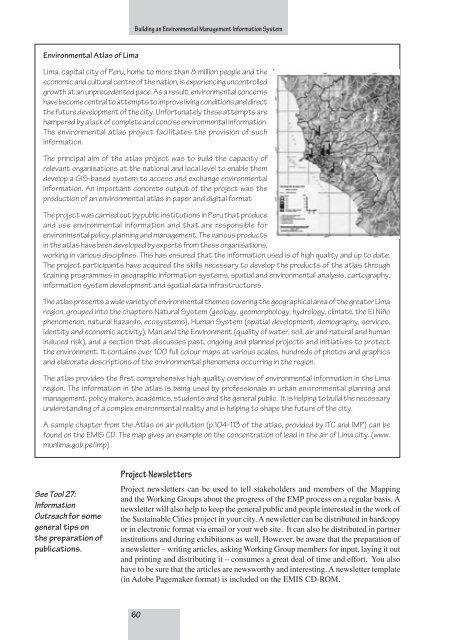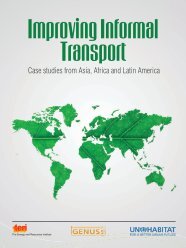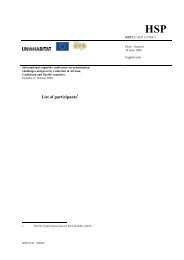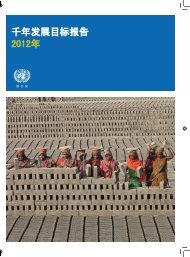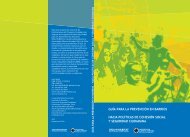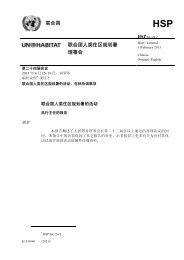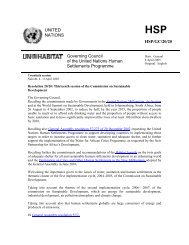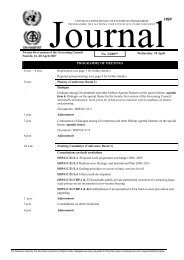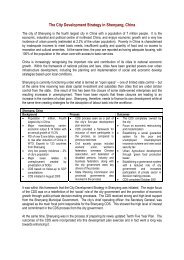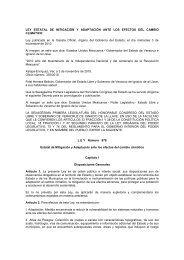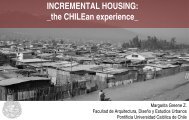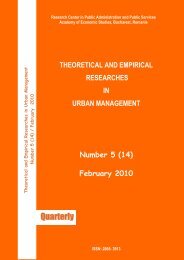EMIS - UN-Habitat
EMIS - UN-Habitat
EMIS - UN-Habitat
You also want an ePaper? Increase the reach of your titles
YUMPU automatically turns print PDFs into web optimized ePapers that Google loves.
Environmental Atlas of Lima<br />
Building an Environmental Management Information System<br />
Lima, capital city of Peru, home to more than 8 million people and the<br />
economic and cultural centre of the nation, is experiencing uncontrolled<br />
growth at an unprecedented pace. As a result, environmental concerns<br />
have become central to attempts to improve living conditions and direct<br />
the future development of the city. Unfortunately these attempts are<br />
hampered by a lack of complete and concise environmental information.<br />
The environmental atlas project facilitates the provision of such<br />
information.<br />
The principal aim of the atlas project was to build the capacity of<br />
relevant organisations at the national and local level to enable them<br />
develop a GIS-based system to access and exchange environmental<br />
information. An important concrete output of the project was the<br />
production of an environmental atlas in paper and digital format<br />
The project was carried out by public institutions in Peru that produce<br />
and use environmental information and that are responsible for<br />
environmental policy, planning and management. The various products<br />
in the atlas have been developed by experts from these organisations,<br />
working in various disciplines. This has ensured that the information used is of high quality and up to date.<br />
The project participants have acquired the skills necessary to develop the products of the atlas through<br />
training programmes in geographic information systems, spatial and environmental analysis, cartography,<br />
information system development and spatial data infrastructures.<br />
The atlas presents a wide variety of environmental themes covering the geographical area of the greater Lima<br />
region, grouped into the chapters Natural System (geology, geomorphology, hydrology, climate, the El Niño<br />
phenomenon, natural hazards, ecosystems), Human System (spatial development, demography, services,<br />
identity and economic activity), Man and the Environment (quality of water, soil, air and natural and human<br />
induced risk), and a section that discusses past, ongoing and planned projects and initiatives to protect<br />
the environment. It contains over 100 full colour maps at various scales, hundreds of photos and graphics<br />
and elaborate descriptions of the environmental phenomena occurring in the region.<br />
The atlas provides the first comprehensive high quality overview of environmental information in the Lima<br />
region. The information in the atlas is being used by professionals in urban environmental planning and<br />
management, policy makers, academics, students and the general public. It is helping to build the necessary<br />
understanding of a complex environmental reality and is helping to shape the future of the city.<br />
A sample chapter from the Atlas on air pollution (p.104-113 of the atlas, provided by ITC and IMP) can be<br />
found on the <strong>EMIS</strong> CD. The map gives an example on the concentration of lead in the air of Lima city. (www.<br />
munlima.gob.pe/imp)<br />
See Tool 27:<br />
Information<br />
Outreach for some<br />
general tips on<br />
the preparation of<br />
publications.<br />
Project Newsletters<br />
Project newsletters can be used to tell stakeholders and members of the Mapping<br />
and the Working Groups about the progress of the EMP process on a regular basis. A<br />
newsletter will also help to keep the general public and people interested in the work of<br />
the Sustainable Cities project in your city. A newsletter can be distributed in hardcopy<br />
or in electronic format via email or your web site. It can also be distributed in partner<br />
institutions and during exhibitions as well. However, be aware that the preparation of<br />
a newsletter – writing articles, asking Working Group members for input, laying it out<br />
and printing and distributing it – consumes a great deal of time and effort. You also<br />
have to be sure that the articles are newsworthy and interesting. A newsletter template<br />
(in Adobe Pagemaker format) is included on the <strong>EMIS</strong> CD-ROM.<br />
60


